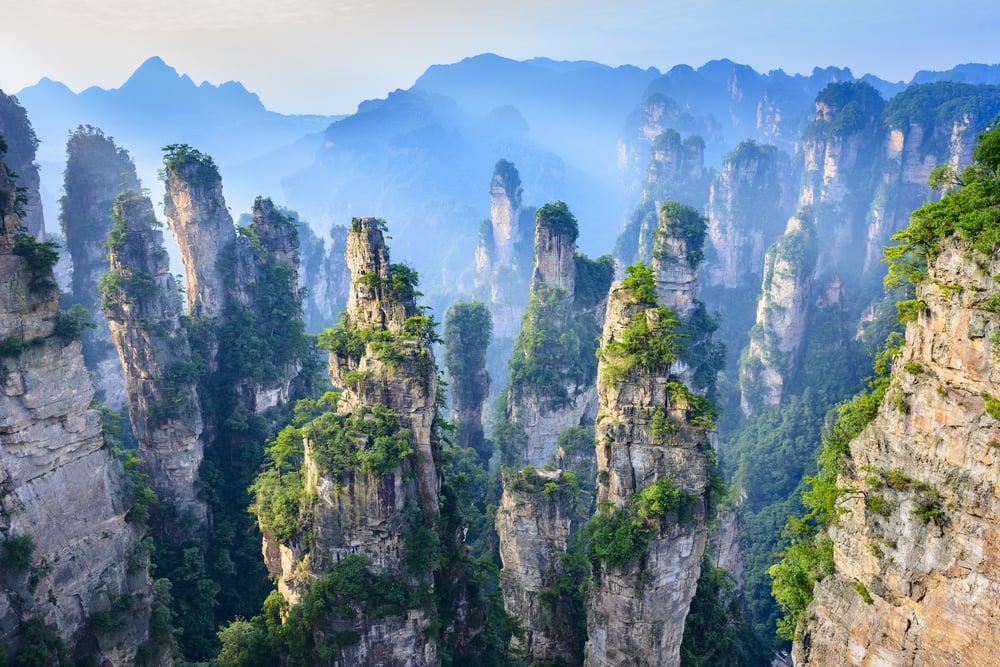
Why is Zhangjiajie so popular?
Zhangjiajie, located in the Hunan province of China, is a destination that captivates travelers worldwide. At its heart lies the Wulingyuan Scenic Area, a UNESCO World Heritage Site and a significant part of Zhangjiajie National Park.
The Unique Landscape of Quartz-Sandstone Pillars
The most striking feature of Zhangjiajie is undoubtedly its unique landscape. Towering quartz-sandstone pillars dominate the scenery, creating an almost surreal panorama. These pillars, sculpted over millions of years by physical and chemical erosion, stand as testaments to the Earth’s powerful natural forces.
| Formation Process of Quartz-Sandstone Pillars | Timeline (Estimated) |
|---|---|
| Deposition of Sandstone: Layers of sand accumulate over time. | Hundreds of millions of years ago |
| Compaction and Cementation: Pressure from overlying sediments compacts the sand, while minerals crystallize between the grains, cementing them into rock. | Millions of years ago |
| Uplift and Exposure: Tectonic forces uplift the sandstone, exposing it to weathering and erosion. | Millions of years ago to present |
| Weathering and Erosion: Wind, rain, and frost gradually break down the exposed sandstone, with the weaker layers eroding faster, leading to the formation of pillars. | Ongoing process |
Yuanjiajie Scenic Area: Inspiration for Avatar's Floating Mountains
Within the Wulingyuan Scenic Area lies Yuanjiajie, a section renowned for its particularly stunning and dramatic formations. These soaring pillars, often shrouded in mist, seem to float in the air, earning them the moniker "floating mountains."
The resemblance to the floating Hallelujah Mountains in the blockbuster movie Avatar is no coincidence. Director James Cameron has cited Zhangjiajie as a direct inspiration for the film's otherworldly landscapes. This connection to Avatar has significantly boosted Zhangjiajie's international profile, attracting movie fans and adventure seekers alike.
Other Reasons for Zhangjiajie's Popularity
Beyond its geological wonders, Zhangjiajie offers a diverse range of attractions and activities:
- Accessibility: Improved infrastructure, including a well-developed network of roads, cable cars, and the Bailong Elevator, the world's tallest outdoor elevator, makes exploring this vast park surprisingly convenient.
- Hiking and Outdoor Activities: Numerous hiking trails cater to all levels of fitness, offering breathtaking views and opportunities to immerse oneself in nature.
- Cultural Experiences: The region is home to the Tujia, Miao, and Bai ethnic minority groups, each with their distinct customs and traditions, adding a cultural layer to the visitor experience.
- Photography Paradise: From the iconic landscapes to the vibrant cultural displays, Zhangjiajie is a photographer’s dream, offering endless opportunities to capture stunning images.
FAQs about Zhangjiajie
Q: When is the best time to visit Zhangjiajie?
A: Spring (April-May) and autumn (September-October) are considered the best times to visit Zhangjiajie. The weather during these seasons is pleasant, offering clear skies and comfortable temperatures.
Q: How many days do I need to visit Zhangjiajie?
A: To fully appreciate the beauty and scope of Zhangjiajie, it is recommended to spend at least 3-4 days exploring the various scenic areas and engaging in activities.
Q: What are some of the must-see attractions in Zhangjiajie?
A: Some of the must-see attractions include:
- Yuanjiajie Scenic Area
- Tianzi Mountain
- The Golden Whip Stream
- Huangshizhai (Yellow Stone Village)
- The Bailong Elevator
- The Glass Bridge